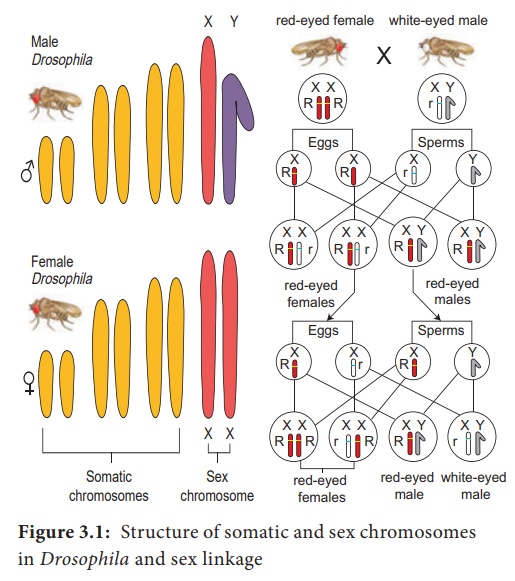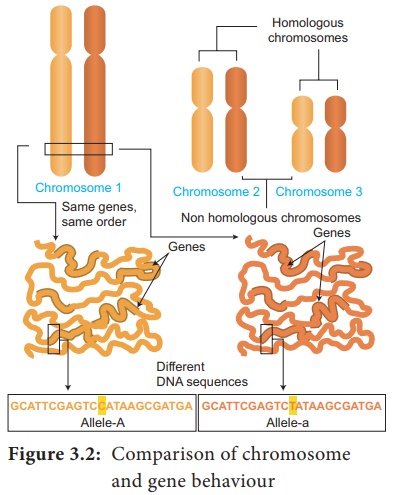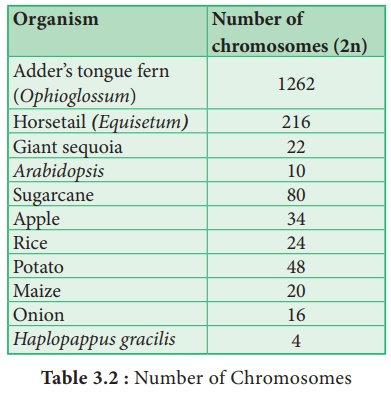Botany - Chromosomal Theory of Inheritance | 12th Botany : Chapter 3 : Chromosomal Basis of Inheritance
Chapter: 12th Botany : Chapter 3 : Chromosomal Basis of Inheritance
Chromosomal Theory of Inheritance
Chromosomal
Theory of Inheritance
G. J. Mendel (1865)
studied the inheritance of well-defined characters of pea plant but for several
reasons it was unrecognized till 1900. Three scientists (de Vries, Correns and
Tschermak) independently rediscovered Mendel’s results on the inheritance of
characters. Various cytologists also observed cell division due to advancements
in microscopy. This led to the discovery of structures inside nucleus. In
eukaryotic cells, worm-shaped structures formed during cell division are called
chromosomes (colored bodies, visualized by staining). An organism
which possesses two complete basic sets of chromosomes are known as diploid. A
chromosome consists of long, continuous coiled piece of DNA in which genes are
arranged in linear order. Each gene has a definite position (locus) on a
chromosome. These genes are hereditary units. Chromosomal theory of inheritance
states that Mendelian factors (genes) have specific locus (position) on
chromosomes and they carry information from one generation to the next
generation.
1. Historical development of chromosome theory
The important
cytological findings related to the chromosome theory of inheritance are given
below.
Wilhelm Roux (1883) postulated that the chromosomes
of a cell are responsible for transferring heredity.
Montgomery (1901) was first to suggest occurrence of distinct pairs of
chromosomes and he also concluded that maternal chromosomes pair with paternal
chromosomes only during meiosis.
T. Boveri (1902) supported the idea that
the chromosomes contain genetic determiners, and he was largely responsible for
developing the chromosomal theory of inheritance.
W.S. Sutton (1902), a young American
student independently recognized a parallelism (similarity) between
the behaviour of chromosomes and
Mendelian factors during gamete formation. Sutton and Boveri (1903)
independently proposed the chromosome theory of inheritance. Sutton united the
knowledge of chromosomal segregation with Mendelian principles and called it
chromosomal theory of inheritance.

2. Salient features of the Chromosomal theory of inheritance
·
Somatic cells of organisms are derived from the zygote by repeated
cell division (mitosis). These consist of two identical sets of chromosomes.
One set is received from female parent (maternal) and the other from male
parent (paternal). These two chromosomes constitute the homologous pair.
·
Chromosomes retain their structural uniqueness and individuality
throughout the life cycle of an organism.
·
Each chromosome carries specific determiners or Mendelian factors
which are now termed as genes.
·
The behaviour of chromosomes during the gamete formation (meiosis)
provides evidence to the fact that genes or factors are located on chromosomes.
3. Support for chromosomal theory of heredity
This theory was widely
discussed and controversies by scientists around the world. However, this
debate has been finally cleared by the works of Thomas Hunt Morgan (1910) on
the fruit fly Drosophila melanogaster (2n=8).
This fruit fly completed
their life cycle within two weeks. The alleles for red or white eye colour are
present on the X chromosome but there is no counter part for this gene on the Y
chromosome.
Thus, females have two
alleles for this gene, whereas males have only one (Figure 3.1). The genetic
results were completely based on meiotic behaviour of the X and Y chromosomes.
Similarly, the genes for yellow body colour and miniature wings are also
carried on the X chromosome. This study strongly supports the idea that genes
are located on chromosomes. The linked genes connected together on sex
chromosome is called sex linkage.
Comparison between gene and chromosome behavior
Around twentieth century
cytologists established that, generally the total number of chromosomes is
constant in all cells of a species. A diploid eukaryotic cell has two haploid
sets of chromosomes, one set from each parent. All somatic cells of an organism
carry the same genetic complement. The behaviour of chromosomes during meiosis
not only explains Mendel’s principles but leads to new and different approaches
to study about heredity.


The important aspects to
be remembered about the chromosome behaviour during cell division (meiosis) are
as follows.
·
The alleles of a genotype are found in the same locus of a
homologous chromosome (A/a) (Figure 3.2).
·
In the S phase of meiotic interphase each chromosome replicates
forming two copies of each allele (AA/aa), one on each chromatid.
·
The homologous chromosomes segregate in anaphase I, thereby
separating two different alleles (AA) and (aa).
·
In anaphase II of meiosis, separation of sister chromatids of
homologous chromosomes takes place. Therefore, each daughter cell (gamete)
carries only a single allele (gene) of a character (A), (A), (a) and (a).

Thomas Hunt Morgan (1933) received
Nobel Prize in Physiology or Medicine for his discoveries concerning the role
played by chromosomes in heredity.
Related Topics